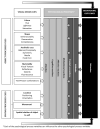Visual Design Cues Impacting Food Choice: A Review and Future Research Agenda
- PMID: 33086720
- PMCID: PMC7589873
- DOI: 10.3390/foods9101495
Visual Design Cues Impacting Food Choice: A Review and Future Research Agenda
Abstract
This review aims to tackle the challenge of understanding how visual design cues can affect behavioural outcomes in a food context. The review answers two key questions: (1) What are the effects of the most important visual design cues on behavioural outcomes and how can they be explained? (2) What are the research gaps in this area? We start from a comprehensive taxonomy of visual design cues delineating the most important visual design cues. Next, we evaluate the extant research based on a structured, narrative literature review on visual design cues in the food domain. We differentiate between object processed and spatially processed visual design cues in food choice contexts and show how they affect behavioural outcomes through a range of psychological processes (attention, affective-, cognitive- and motivational reactions, food perceptions and attitudes). We end with recommendations which take into account the current food store context, the state-of-art in measuring psychological processes and behavioural outcomes and the specific food-, person- and context-related moderators. This review offers guidance for research to untangle the complexity of the effect of visual design cues in a food choice context.
Keywords: attitudes; behaviour; food choice; food perception; healthy; point of purchase; psychological processes; quality; sustainable; taste; visual cue.
Conflict of interest statement
The authors declare no conflict of interest.
Figures
References
-
- Bell D.R., Corsten D., Knox G. From point of purchase to path to purchase: How preshopping factors drive unplanned buying. J. Mark. 2011;75:31–45. doi: 10.1509/jm.75.1.31. - DOI
-
- Cameron A.J., Charlton E., Ngan W.W., Sacks G. A systematic review of the effectiveness of supermarket-based interventions involving product, promotion, or place on the healthiness of consumer purchases. Curr. Nutr. Rep. 2016;5:129–138. doi: 10.1007/s13668-016-0172-8. - DOI
-
- Hoyer W.D. An examination of consumer decision making for a common repeat purchase product. J. Consum. Res. 1984;11:822–829. doi: 10.1086/209017. - DOI
-
- Suher J., Hoyer W.D. The moderating effect of buying impulsivity on the dynamics of unplanned purchasing motivations. J. Mark. Res. 2020;57:548–564. doi: 10.1177/0022243720912284. - DOI
Publication types
LinkOut - more resources
Full Text Sources


